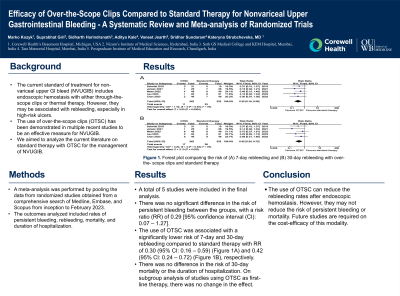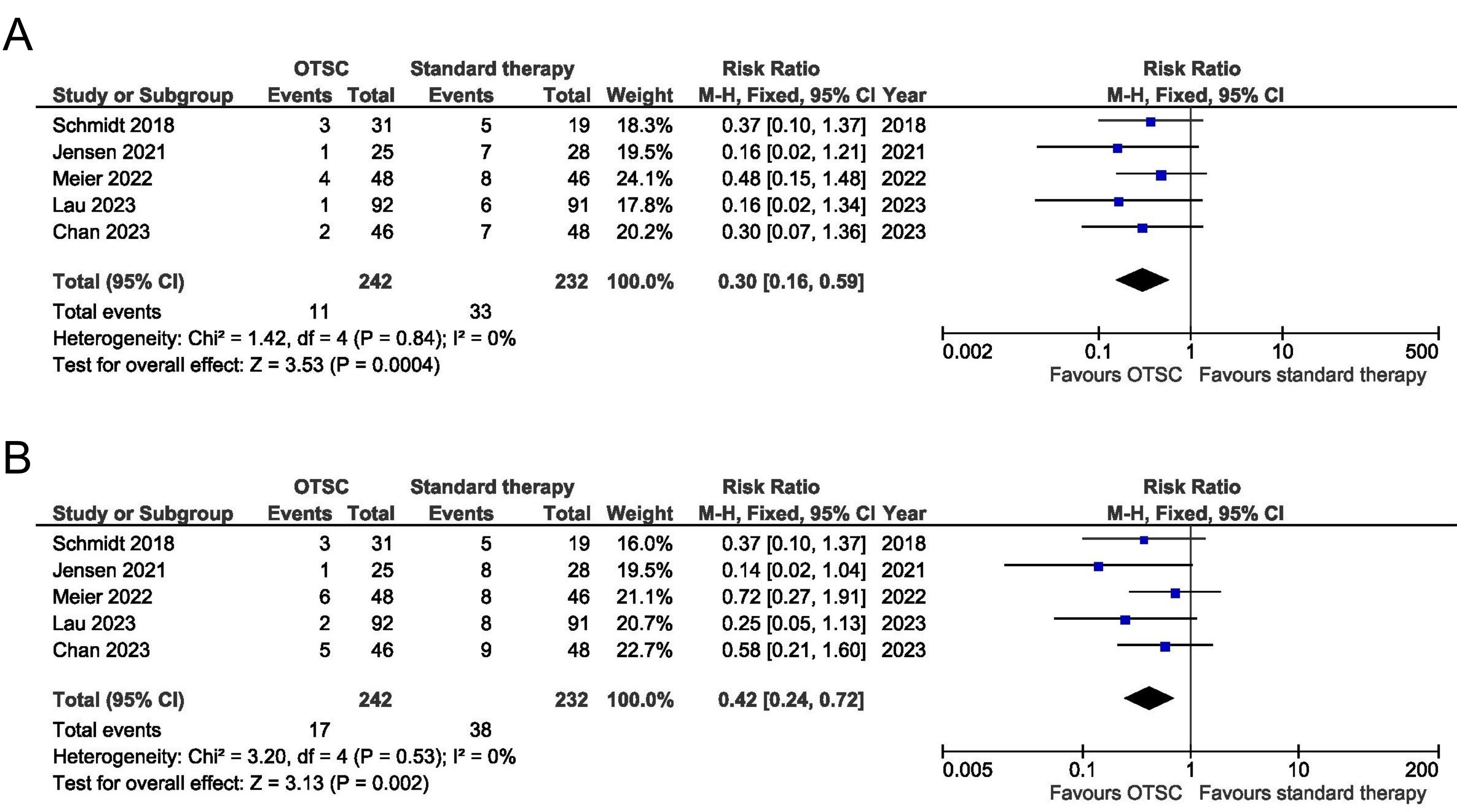Tuesday Poster Session
Category: General Endoscopy
P3402 - Efficacy of Over-the-Scope Clips Compared to Standard Therapy for Nonvariceal Upper Gastrointestinal Bleeding - A Systematic Review and Meta-Analysis of Randomized Trials
Tuesday, October 24, 2023
10:30 AM - 4:00 PM PT
Location: Exhibit Hall

Has Audio

Marko Kozyk, MD
Corewell Health William Beaumont University Hospital
Royal Oak, MI
Presenting Author(s)
Award: Presidential Poster Award
Marko Kozyk, MD1, Suprabhat Giri, MD2, Sidharth Harindranath, MD3, Aditya Kale, MD4, Vaneet Jearth, MD5, Sridhar Sundaram, MD4, Kateryna Strubchevska, MD1
1Corewell Health William Beaumont University Hospital, Royal Oak, MI; 2Nizam’s Institute of Medical Sciences, Hyderabad, Telangana, India; 3Seth GS Medical College and KEM Hospital, Mumbai, Maharashtra, India; 4Tata Memorial Hospital, Mumbai, Maharashtra, India; 5Postgraduate Institute of Medical Education and Research, Chandigarh, Chandigarh, India
Introduction: The current standard of treatment for non-variceal upper GI bleed (NVUGIB) includes endoscopic hemostasis with either through-the-scope clips or thermal therapy. However, they may be associated with rebleeding, especially in high-risk ulcers. The use of over-the-scope clips (OTSC) has been demonstrated in multiple recent studies to be an effective measure for NVUGIB. We aimed to analyze the current literature on standard therapy with OTSC for the management of NVUGIB.
Methods: A meta-analysis was performed by pooling the data from randomized studies obtained from a comprehensive search of Medline, Embase, and Scopus from inception to February 2023. The outcomes analyzed included rates of persistent bleeding, rebleeding, mortality, and duration of hospitalization.
Results: A total of 5 studies were included in the final analysis. There was no significant difference in the risk of persistent bleeding between the groups, with a risk ratio (RR) of 0.29 [95% confidence interval (CI): 0.07 – 1.27]. The use of OTSC was associated with a significantly lower risk of 7-day and 30-day rebleeding compared to standard therapy with RR of 0.30 (95% CI: 0.16 – 0.59) (Figure 1A) and 0.42 (95% CI: 0.24 – 0.72) (Figure 1B), respectively. There was no difference in the risk of 30-day mortality or the duration of hospitalization. On a subgroup analysis of studies using OTSC as a first-line therapy, there was no change in the effect.
Discussion: The use of OTSC can reduce the rebleeding rates after endoscopic hemostasis. However, OTSC may not reduce the risk of persistent bleeding or mortality. Future studies are required on the cost-efficacy of this modality.

Disclosures:
Marko Kozyk, MD1, Suprabhat Giri, MD2, Sidharth Harindranath, MD3, Aditya Kale, MD4, Vaneet Jearth, MD5, Sridhar Sundaram, MD4, Kateryna Strubchevska, MD1. P3402 - Efficacy of Over-the-Scope Clips Compared to Standard Therapy for Nonvariceal Upper Gastrointestinal Bleeding - A Systematic Review and Meta-Analysis of Randomized Trials, ACG 2023 Annual Scientific Meeting Abstracts. Vancouver, BC, Canada: American College of Gastroenterology.
Marko Kozyk, MD1, Suprabhat Giri, MD2, Sidharth Harindranath, MD3, Aditya Kale, MD4, Vaneet Jearth, MD5, Sridhar Sundaram, MD4, Kateryna Strubchevska, MD1
1Corewell Health William Beaumont University Hospital, Royal Oak, MI; 2Nizam’s Institute of Medical Sciences, Hyderabad, Telangana, India; 3Seth GS Medical College and KEM Hospital, Mumbai, Maharashtra, India; 4Tata Memorial Hospital, Mumbai, Maharashtra, India; 5Postgraduate Institute of Medical Education and Research, Chandigarh, Chandigarh, India
Introduction: The current standard of treatment for non-variceal upper GI bleed (NVUGIB) includes endoscopic hemostasis with either through-the-scope clips or thermal therapy. However, they may be associated with rebleeding, especially in high-risk ulcers. The use of over-the-scope clips (OTSC) has been demonstrated in multiple recent studies to be an effective measure for NVUGIB. We aimed to analyze the current literature on standard therapy with OTSC for the management of NVUGIB.
Methods: A meta-analysis was performed by pooling the data from randomized studies obtained from a comprehensive search of Medline, Embase, and Scopus from inception to February 2023. The outcomes analyzed included rates of persistent bleeding, rebleeding, mortality, and duration of hospitalization.
Results: A total of 5 studies were included in the final analysis. There was no significant difference in the risk of persistent bleeding between the groups, with a risk ratio (RR) of 0.29 [95% confidence interval (CI): 0.07 – 1.27]. The use of OTSC was associated with a significantly lower risk of 7-day and 30-day rebleeding compared to standard therapy with RR of 0.30 (95% CI: 0.16 – 0.59) (Figure 1A) and 0.42 (95% CI: 0.24 – 0.72) (Figure 1B), respectively. There was no difference in the risk of 30-day mortality or the duration of hospitalization. On a subgroup analysis of studies using OTSC as a first-line therapy, there was no change in the effect.
Discussion: The use of OTSC can reduce the rebleeding rates after endoscopic hemostasis. However, OTSC may not reduce the risk of persistent bleeding or mortality. Future studies are required on the cost-efficacy of this modality.

Figure: Figure 1. Forest plot comparing the risk of (A) 7-day rebleeding and (B) 30-day rebleeding with over-the-scope clips and standard therapy
Disclosures:
Marko Kozyk indicated no relevant financial relationships.
Suprabhat Giri indicated no relevant financial relationships.
Sidharth Harindranath indicated no relevant financial relationships.
Aditya Kale indicated no relevant financial relationships.
Vaneet Jearth indicated no relevant financial relationships.
Sridhar Sundaram indicated no relevant financial relationships.
Kateryna Strubchevska indicated no relevant financial relationships.
Marko Kozyk, MD1, Suprabhat Giri, MD2, Sidharth Harindranath, MD3, Aditya Kale, MD4, Vaneet Jearth, MD5, Sridhar Sundaram, MD4, Kateryna Strubchevska, MD1. P3402 - Efficacy of Over-the-Scope Clips Compared to Standard Therapy for Nonvariceal Upper Gastrointestinal Bleeding - A Systematic Review and Meta-Analysis of Randomized Trials, ACG 2023 Annual Scientific Meeting Abstracts. Vancouver, BC, Canada: American College of Gastroenterology.

